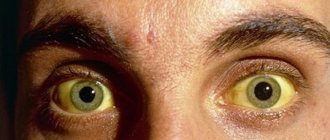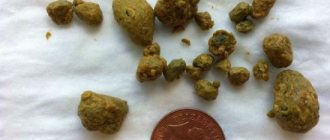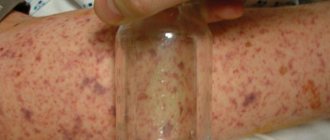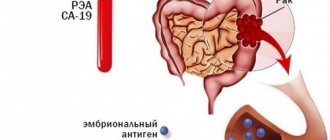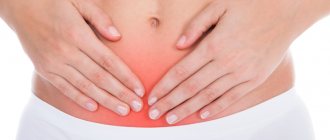Photo: LynxDaemon
The color of stool largely determines the state of the human digestive system. This applies to both children and adults. An indicator of absolutely normal functioning of the gastrointestinal tract is the brown color of feces. And in order to understand why poop is brown, it is worth remembering that this color appears due to the enzyme bilirubin, which is produced by the pancreas. It is he who ensures complete processing of food and brown feces.
Stool color is often affected by food. In this case, the changes quickly pass as soon as the person begins to eat according to his usual diet. But there are also diseases that cause discoloration of stool. In such cases, there are a number of other symptoms that need to be monitored correctly and promptly, and seek help.
Causes of changes in stool color
Each person's digestive processes are individual. Throughout life, they constantly change under the influence of a large number of different factors. The reasons for the atypical color of feces are different in adults and children.
Change in color of baby's stool
In infants, the digestive organs are still immature and cannot sufficiently perform all their functions. And that is why the baby often has a gray coloration of stool. Nutrition has a significant impact on their condition and appearance.
If a child is breastfed, then his digestive system gradually adapts to external conditions. The gray color of feces is observed when the child begins to be fed with artificial nutritional formulas.
In healthy children, adaptation of the digestive system is completed within several months after the transition to artificial feeding and the introduction of complementary foods. By the age of one year, the development of the gastrointestinal tract in babies is completed.
Change in stool color in adults
Normally, men and women have brown stool. Discoloration of stool indicates disturbances in the flow of bile into the duodenum.
The following reasons cause gray stool:
- inflammation of the gall bladder;
- blockage or dyskinesia of the biliary tract;
- liver inflammation;
- diseases of the rectum;
- intestinal infection;
- inflammation of the pancreas;
- Crohn's disease;
- helminthic infestation;
- tumors in the liver, pancreas or gall.
The appearance of gray feces with a pungent odor indicates the development of severe inflammatory pathologies in the digestive tract. Most often this occurs as a result of pancreatitis or severe putrefactive dyspepsia .
Use of medications
Sometimes gray coloration of stool appears as a result of the fact that a person uses certain medications:
- medicines containing bismuth compounds;
- activated carbon;
- antifungal drugs;
- anti-gout medications;
- antiepileptic drugs;
- Ibuprofen;
- aspirin.
The appearance of dark stool in these cases requires discontinuation of the drug, diagnosis of the patient and the appointment of appropriate treatment.
During pregnancy
The appearance of gray stool during pregnancy may indicate that the pregnant woman eats a lot of fruits and vegetables. If there is no pain and no mucus appears in the stool, then this condition is normal. The problem will disappear if you slightly adjust your diet during pregnancy.
If abdominal pain appears, a change in the nature of bowel movements, or yellowing of the skin, a woman should urgently consult a doctor, because these signs indicate the development of dangerous diseases of the digestive tract.
How does eating a vegetable affect the color of stool?
Beets have a rich red-violet color due to the presence of special substances in their composition - betacyanins.
The coloring pigments of the plant are processed and discolored when they enter the stomach, and further, passing through the internal organs and intestines. In certain cases, the natural dyes in beets are not absorbed and the plant may stain feces. The effect of root vegetables on feces can be both within normal limits and due to possible health problems.
Natural causes of color changes
- Metabolism and absorption rate. With different levels of metabolism, the coloring pigments of beets are either completely broken down, then it does not color the secretions, or they do not have time to be partially processed, and are excreted along with the feces, coloring it in burgundy shades.
- Individual abilities of the body to digest pigments. A certain percentage of people normally have a lack or absence of bacteria that break down the coloring pigments of beets. In this case, after eating the root vegetable, the stool is consistently colored in a beetroot shade, they are very similar to blood.
- Volume of beets eaten. If the vegetable is consumed infrequently and in small quantities, the feces may remain unchanged. When the volume of beets in food increases, or daily consumption of dishes or juices from it, excess coloring substances will be excreted along with excrement (we talked about whether it is possible to eat a vegetable every day, what the consumption rate is and the dangers of exceeding it, we talked in our article).
What foods can stain stool?
Some foods can lighten stool, causing it to appear gray.
This phenomenon occurs when consuming large quantities:
- milk and dairy products;
- lard;
- oils;
- confectionery products;
- potatoes;
- rice;
- high-calorie dishes;
- alcoholic drinks.
With an appropriate change in diet, this problem disappears; the color of a person’s stool gradually becomes brown.
How many days does the product leave the body?
The burgundy color of feces appears a few hours after eating beets. The stool returns to its usual color within one or two days after eliminating the root vegetable from the diet.
If there is stagnation of feces in the intestines and it is not immediately completely eliminated from the body, the reddish color can persist for up to three to four days.
A change in the color of stool after eating beets can be both a variant of the norm and an indicator of the state of the body’s digestive system. The effect of a vegetable on discharge varies depending on the food consumed and the person’s health.
If after beets the color of the stool remains unchanged, then everything has been assimilated as fully as possible. If, after eating the root vegetable, the feces turn burgundy, you still feel good, and after eliminating beetroot dishes, the color of the feces is restored, you can continue to include this healthy vegetable in your diet.
If you find an error, please select a piece of text and press Ctrl+Enter.
What determines the color of stool? Why is normal stool dark or light brown and why does it turn black, green or yellow? When should you be concerned, and when can a change in the color of your stool be attributed to your diet?
Dark gray feces
A person may develop a dark gray tint. As a rule, it has a very unpleasant putrid odor. This happens with diseases of the digestive tract:
- Dyspepsia is a violation of the secretory function of the gastrointestinal tract and a decrease in the acidity of gastric juice. In sick people, the normal microflora of the mucous membrane of the digestive organs changes dramatically.
- Inflammation of the colon mucosa. This can produce a significant amount of hydrogen sulfide.
- Acute dysbacteriosis. In this case, due to altered bacterial flora, insufficient breakdown and digestion of food occurs. This condition is accompanied by belching, heaviness in the abdomen, and an unpleasant taste in the mouth.
- Inflammatory diseases of the pancreas. Acute pancreatitis is a life-threatening condition and always requires immediate surgical treatment.
What indicates health problems?
Feces after beets indicate possible problems in the body in the following cases:
- A long-term change in the color of stool after beets, two-colored stool (some red, some normal) is a consequence of insufficient digestion. Possibly as a result of eating disorders, with frequent overeating, when the intestinal walls are clogged and do not work satisfactorily.
- Liquid stool with pieces of beets and undigested parts of other food indicate malfunctions in the intestines.
- The appearance of too light a shade of feces after beets indicates a malfunction of the gallbladder, pancreas and liver.
- Blood in the stool signals internal damage to the digestive tract.
Beetroot is a healthy and nutritious root vegetable that has a whole range of beneficial substances. Without them, normal functioning of the body is impossible. Is it possible to eat beets for people with stomach and duodenal ulcers, diabetes, oncology, cholelithiasis, gastritis, pancreatitis and cholecystitis, as well as how to treat the liver, sore throat and runny nose with beet juice - read on our website.
When to sound the alarm
The following signs should alert you and force you to consult a doctor as soon as possible, as they indicate disturbances in the functioning of the digestive tract:
- pain in the abdomen in any area, especially after eating;
- yellow skin color;
- increased body temperature;
- nausea;
- vomit;
- change in urine color;
- loss of body weight;
- decreased appetite;
- bloating;
- diarrhea or constipation;
- deterioration of condition.
The appearance of these symptoms along with the presence of gray feces indicates the development of severe digestive pathologies.
If the consistency of stool has changed (they have become solid or, conversely, liquid), this indicates the addition of inflammatory pathologies of the intestines, stomach, liver, and pancreas. These diseases should never be ignored.
Untreated inflammatory pathologies of the gastrointestinal tract can lead to the development of oncological processes.
How are stools colored?
Feces after beets can turn different shades of red - from pink to dark burgundy, and even black. The degree of staining of stool is affected by:
- the saturation of different varieties of root vegetables with coloring pigments;
- combination with other products and medications;
- possible disturbances in the gastrointestinal tract.
Attention! Beets have a mild laxative effect and help with constipation. Use with caution if you are prone to diarrhea and intestinal disorders!
Can they be red (pink)?
- After eating light varieties of vegetables.
- When combining a vegetable with other red-colored foods (tomatoes, red berries).
- From the simultaneous use of root vegetables with antibiotics or potassium tablets.
Why are they black?
- When consuming dark varieties of beets in large quantities.
- As a result of simultaneous use with products that have a lot of dark coloring pigments:
- prunes;
- red grapes;
- blueberries;
- black currant;
- strong coffee;
- sausage products.
- When combining the plant with certain medications:
- iron-containing products;
- activated carbon;
- bismuth preparations;
- antibiotics.
- From combination with low-quality alcohol.
Diagnostics
If gray stool appears, you should consult a physician, gastroenterologist or pediatrician.
The doctor will prescribe the following diagnostic tests:
- Bacteriological analysis of stool. It will help determine the presence of helminthiasis, occult blood and dysbacteriosis.
- Microscopic examination helps to identify the presence of pathogens of infectious pathologies.
- Tests for worm eggs.
- Biochemical analysis makes it possible to evaluate the intestinal microflora and establish its pathologies.
- Endoscopic examination. It will help detect diseases of the esophagus and stomach.
- Colonoscopy. This examination will make it possible to diagnose pathologies of the rectum and large intestine.
Question: Can black stool be caused by iron supplements?
The site provides reference information for informational purposes only.
Diagnosis and treatment of diseases must be carried out under the supervision of a specialist. All drugs have contraindications. Consultation with a specialist is required! Could black stool be from iron supplements?
Yes, any iron supplements and even a number of products that contain this trace element in large quantities can cause stool to turn black. This is due to the fact that iron, during biochemical transformations, is oxidized to hemin or oxide, which has a black color. These iron compounds (oxide or hemin) remain in the intestinal lumen, moving towards the anus along with the feces. As a result, black iron compounds mix well with feces and also color them black.
Iron preparations not only color stool black, but also give it a specific odor. However, this is a variant of the physiological reactions of the body, so no additional interventions or discontinuation of iron supplements are required. After stopping the course of taking iron supplements, the stool will return to its normal color.
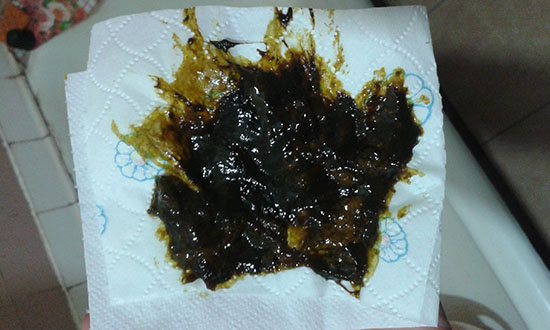
Treatment
If a deviation in stool color is detected, treatment for the underlying disease is prescribed. For pancreatitis, a diet is indicated. In severe cases, surgery is required.
Treatment of hepatitis is aimed at eliminating etiological factors. The patient is strictly prohibited from drinking alcohol. Hepatoprotectors are prescribed.
In other cases, correction of nutrition and lifestyle is indicated. Eliminating fast food, fried and smoked foods helps normalize a person’s condition.
The diet should consist of vitamin dishes that are easily digestible and do not lead to irritation of the gastrointestinal mucosa.
Gray coloration in stool can sometimes appear for physiological reasons. In this case, there is no reason to panic. The color of feces will become normal after the diet is brought back to normal. With the development of pathological conditions of the digestive tract, effective treatment is necessary as prescribed by a doctor.
Why are there pieces of undigested vegetables?
- High fiber content in the plant. When consumed in large quantities, beet fiber is partially not digested, and then pieces of the root vegetable may be present in the feces. If you feel normal and there is no discomfort, then the presence of pieces of beets in the stool is considered acceptable.
- Intestinal disorders. Due to the laxative effect, eating beets in combination with spicy foods, large amounts of vegetables and fruits sometimes leads to diarrhea, incomplete digestion and the appearance of pieces of the plant in the excrement. This condition in isolated cases is not a pathology and goes away with hygiene and a reasonable combination of products.
- Disturbances in the digestive system. Large undigested parts of beets and other food in the feces, poor health and abnormal bowel movements for a long time signal problems in the body.
Stool after eating root vegetables in children and adults - what is the difference?
In young children, the digestive system is not developed and reacts more quickly to changes in diet. The younger the child, the more difficult it is for the child’s body to cope with excess amounts of beet fiber. When complementary foods are first introduced, beets are excreted in the feces almost unchanged. In older children, the stool after root vegetables becomes liquefied, turns shades of red and contains pieces of undigested vegetables.
As the child grows, more enzymes appear that help in the processing of beets, the food digestion system is fully formed, and the vegetable begins to be absorbed in large volumes.
On a note! In children, beets often affect not only the color of stool, but also turn the urine reddish. This is allowed if the child feels normal, and a change in red color occurs after removing the root vegetable from the diet.
Black stool from vitamins containing iron
Many people ask whether the color of stool changes when taking vitamin complexes containing iron. Sometimes it happens. This is explained by the fact that most formulations contain not only vitamins, but also mineral supplements, one of which is iron. Once in the stomach, under the influence of hydrochloric acid it will oxidize, pass through the intestinal tract, mix with feces, giving it a black tint. In addition, the metal will cause a special smell of biological masses, and in some cases cause constipation.
Some doctors claim that when taking vitamins, the stool turns black due to excess iron that is not absorbed by the esophagus.
It is believed that vitamins can give a black color to the stool of both children and adults. In this case, the change will be of a physiological nature, which is provided by the manufacturer of the complex and is reflected in the accompanying instructions.
Black feces in expectant mothers when taking iron
For pregnant women, for normal fetal development, doctors often recommend multivitamin formulations containing iron, after taking which the feces become black. This condition is completely normal and does not require treatment. Experts assure that this is how the expectant mother’s body gets rid of excess iron and recommend not interrupting the intake of vitamins. But if a pregnant woman passes black stool not from taking products containing iron, then she will have to urgently donate blood for a general and biochemical analysis.
If a woman suffers from an ulcer, she is prescribed a stool test to detect occult blood. Loose, dark-colored stools, accompanied by signs of collapse, pallor and cold sweat, indicate an urgent need to see a specialist.
Dark color of stool when a pregnant woman takes iron may be a sign of a dangerous disease that will require urgent treatment.
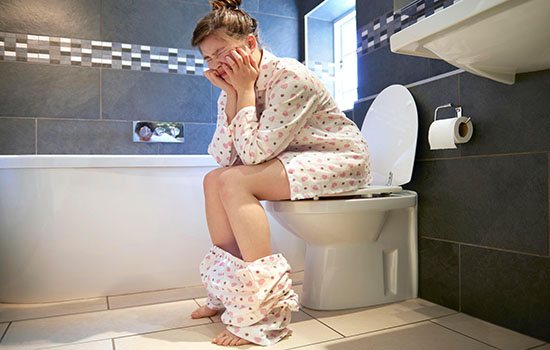
When prescribed to infants
For a woman carrying a child, a lack of iron in the body can be dangerous. The fact is that it is its molecules that transport all nutritional components. And no matter what nutrition is prescribed, the baby’s body will not absorb the necessary substances.
An infant may be prescribed Maltofer in the following cases:
- with anemia;
- during artificial feeding;
- premature or dystrophic children;
- if you gain weight slowly.
The duration of the appointment is prescribed by the doctor. In the case of a premature baby, the duration can be up to five months.



